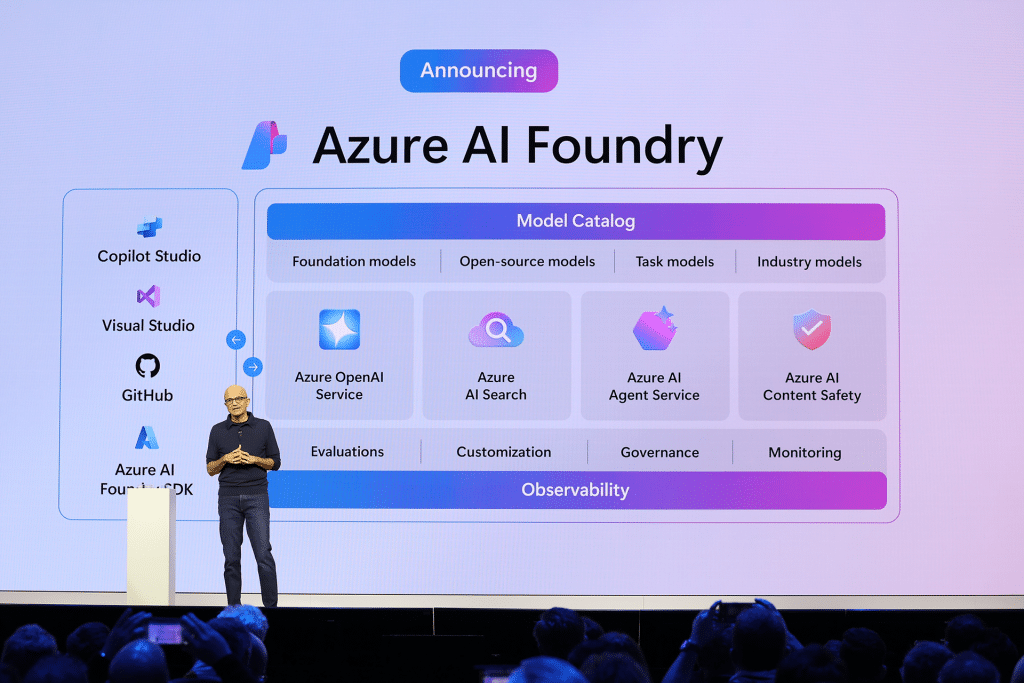Best Practices in AI Development: Ensuring Model-Agnostic Customisations

Approximately 42% of enterprise-scale companies have actively deployed AI, while 40% are in the experimentation phase.1 Why is the percentage of businesses interested in AI but hesitant to implement it so high?
In my view, it is largely down to the speed at which the AI market is moving; businesses don’t want to employ AI technology now, and miss out on technological developments later down the line.
The key to overcoming this challenge is to employ model-agnostic systems that are flexible, scalable, and adaptable enough to allow businesses to implement new AI technology as and when it emerges. In this article, I’ll outline what model-agnosticism is, why it’s important, and how it can enhance the benefits of AI.
Suggested reading: Learn more about the importance of a secure software system in AI implementation by reading the FundingImpact.AI case study.
Understanding model-agnostic AI
Model agnosticism involves setting up your system architecture in a way that facilitates the use of different AI models. This means that you can run specific functions, like data processing, feature extraction, or analysis, using whichever model is best-suited to the task. Model-agnostic AI systems have a few key advantages:
- Strong system architecture: Being able to switch models without making changes to the architecture saves time and allows you to more effectively implement tools according to a user-oriented task-based framework.
- Improved resilience: If one AI tool fails or is discontinued, you are not reliant on it to continue using AI within your business.
- Long-term growth: New AI models are regularly being released. A model-agnostic approach means you can try new technology as and when it emerges to lead innovation in your field.
It’s worth noting that model-agnostic systems treat all AI models as a black box, and can only provide explainability if the selected AI model also offers explainability. For this reason, choosing the right underlying AI model is essential.
Best practices for model-agnostic AI development
AI implementation is still a relatively new and developing area of expertise. Even experienced software developers may not feel confident in the best practices for creating a model-agnostic AI system. Here are some key considerations for developing resilient and flexible infrastructure:
- Algorithm independence
Using abstraction layers is an effective way to ensure your overall system is independent from individual AI algorithms. This ‘middleware’ layer acts as a barrier, with your tool or application interacting with an interface rather than the model directly. This is especially beneficial when it comes to:
- Data transformations
- Model selection
- Error handling
If and when you choose to switch out your AI model, you can do so easily without impacting the integrity of the system architecture. For example, if you are wanting to use generative AI to perform automatic content generation tasks, you can build a model-agnostic system with abstraction layers to easily switch between different NLP models like GPT-3, BERT, and T5, and compare their results.
Learn more: Some tools, such as Microsoft Azure AI Services, provide access to multiple AI models through a single user portal. Read my recent article, ‘Integrating Azure Open AI into your Business Workflows’, to learn more.
- Data normalisation
72% of large businesses in 2024 analyse their data for new insights or knowledge, compared to 58% of medium businesses and 34% of small businesses.2 These statistics alone show the clear connection between data analysis and business growth, and point to the importance of effective data cleaning, processing, and normalisation.
And AI use only increases the necessity of normalisation. For a truly model-agnostic AI integration approach, ensure that data preprocessing and normalisation steps have been standardised across your network to allow input data to be used across multiple models without modification. This might include:
- ‘Data lake’ implementation
- API interaction standardisation
- Developing preprocessing pipelines
- Developing automated data pipelines
The resulting data should have standardised input data formats and numerical values, and should be able to extract all relevant features for forecasting models.
- Modular architecture
Model-agnostic solutions are, by nature, solutions with low coupling. This means there is a low level of interdependence between the components of a software system, enabling improved adaptability and flexibility. To achieve a system with low coupling, you should strive for modular architecture in which individual components such as data processing or feature extraction can be easily replaced or upgraded without the need for overall system downtime.
You can use existing frameworks or build your own to develop your modular system. The key to a strong overall architecture is not necessarily in which individual framework you choose, but how it is implemented. Using containerisation techniques will allow you to package and deploy models independently of one another, and microservice architecture can also be used to develop individual components and independent services.
While the best-fit solution will vary from business to business, I generally recommend that businesses build their system architecture within a cloud-based environment to reduce the risk of incompatibility with different AI tools and improve system security.
- Cross-model validation
Cross-validation is the process of assessing how well an AI tool is working and whether it is reaching its full potential in a specified context. This process might involve first creating a benchmarking framework with which to evaluate each model, before then running A/B testing to compare the performance of models in real-world scenarios.
During your testing, make sure to check how well each AI model handles:
- High-stress workloads: To assess overall AI performance.
- High-complexity information: To check for inaccuracies or potential biases.
- Structured and unstructured data processing: To assess the effectiveness of your tool as well as the way your data has been prepared.
The results of this testing will indicate whether your chosen AI solutions are succeeding against key performance indicators and, if they are not, how you can adjust your system to accommodate improvements. It will also give you the opportunity to check whether your selected tools meet responsible AI use principles and compliance requirements.
- API standardisation
Businesses are putting their trust in AI, with 87% of global organisations believing that using AI will give them a competitive edge.3 Realistically, only those who implement AI within a tailored, adaptable, and secure architecture will reap its key benefits.
When building a model-agnostic system, you should use API standardisation and unified API endpoints to enable consistent data exchanges between each AI model and the overarching system. This will allow you to easily integrate new models as they emerge, keeping you up-to-date with the latest developments in AI technology.
If you are building a tool that processes image data, for example, you might create a unified API to handle AI image preprocessing, data exchanges between models, and final data collection to ensure all of your results are released in a standardised format.
The challenges and solutions of implementing model-agnostic customisations
However you choose to implement AI in your business, it’s important to devote the necessary time and attention to your existing systems and software. Otherwise, you risk ending up with an AI solution that is ineffective or, worse, harmful to your business processes.
Some common AI integration challenges that can come with model-agnostic customisations include:
- Evolving technology: AI technology is developing all the time, and while model-agnostic customisations make adjustments easier, each new AI tool you choose to implement will still require performance testing and compliance checks.
- Increased complexity: Without the right infrastructure in place, low coupling levels can increase the risk of data silos and system complexity.
- Low explainability: The level of explainability you have will depend on whether the AI models you choose offer full transparency and explainability.
To avoid and overcome these challenges you will need to have someone with a high level of AI implementation expertise on your team. This doesn’t necessarily mean hiring a specialist in-house team, but could instead include:
- Working with AI consultants
- Establishing an AI R&D team
- Investing in ongoing developer training
- Engaging with the AI research community
Working with a trusted technology partner is, in my view, the most cost- and resource-efficient way to ensure the smooth implementation of model-agnostic AI systems. Your partner can provide advice and implementation support, working closely alongside your existing team to enable ongoing education.
Build resilient AI infrastructure tailored to your needs
AI is here for the long term. Building resilient, modular, and model-agnostic infrastructure is crucial to achieving long-term benefits with AI. Not only do model-agnostic solutions promote flexibility and improve security, they also allow businesses to achieve a strategic advantage by making it easier to implement new AI models and tools.
Here at Talk Think Do, we work closely with businesses of different sizes and sectors to develop tailored, long-term AI solutions that serve their unique needs and requirements. Most recently, we worked with a leading charitable funding business to build and implement a custom Azure-based AI tool to empower funders with AI-driven insights.
Ready to discover your best-fit AI solution? Book a free consultation with a member of our team to learn more about the AI implementation process and how AI could benefit your business.
1 Data Suggests Growth in Enterprise Adoption of AI is Due to Widespread Deployment by Early Adopters
Get access to our monthly
roundup of news and insights
You can unsubscribe from these communications at any time. For more information on how to unsubscribe, our privacy practices, and how we are committed to protecting and respecting your privacy, please review our Privacy Policy.
See our Latest Insights
The platform for advanced AI apps in 2025
The recent announcements at Microsoft Ignite 2024, particularly the introduction of Microsoft Fabric’s SQL Database and Azure AI Foundry, present significant advancements that align seamlessly with our mission to deliver cutting-edge generative AI implementations for our clients. Enhancing Generative AI Implementations with Microsoft Fabric’s SQL Database The SQL Database in Microsoft Fabric is engineered to…
Customising Microsoft Copilot: Exploring Options for Tailored AI Assistance
If you’ve been following AI developments in 2024, Microsoft Copilot is a tool you’re likely already familiar with. Aimed at improving workplace productivity, streamlining decision-making, and optimising business processes, Copilot is being used by tens of thousands of people at an impressive 40% of Fortune 100 companies.1 While it’s still too early to tell what…
Evaluating AI Tools Using a Task-Based Framework to Optimise Productivity
We’ve all heard about how AI can improve productivity, boost work quality, and open doors to new business opportunities. But the reality is that these kinds of successful results rely on considerable preparation and careful implementation. According to recent surveys, 63% of respondents in successful businesses say that the implementation of generative AI is a…
Legacy systems are costing your business growth.
Get your free guide to adopting cloud software to drive business growth.




